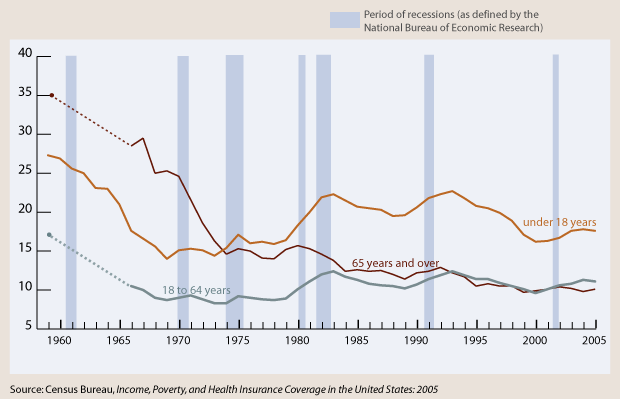Managing the Aging Population
The elderly have financial difficulties primarily because they are too old to hold a job, and thus have no regular income, yet they incur large medical expenses as a result of diminishing health. However, due to the improvement in medical technology, more seniors are living longer and more fulfilling lives, yet still struggle financially. Because of this trend of impoverishment, the United States has enacted social policies designed to help the elderly manage their financial woes. Major policy efforts include Social Security, a social welfare program that taxes the current working sector to give money to individuals in retirement, and Medicare, a federal program that subsidizes medical costs for seniors. Prior to the introduction of Social Security, the elderly were the poorest age group in the United States. With the introduction of Social Security, poverty rates of the elderly in the United States have dropped dramatically. Between 1960 and 1995, the official poverty rate of those aged 65 and above fell from 35 percent to 10 percent, according to the National Bureau of Economic Research. However, due to a lack of funds, that number is beginning to increase once again.
Social Security
Social Security is designed to redistribute wealth temporarily in order to help seniors finance their lives after retirement. In this program, the current workforce is taxed, the results of which flow into a special fund designated for Social Security. Payments are then made from this fund to retirees. This is not, however, simple redistribution. The workforce that is currently contributing to the fund will then retrieve payments once they retire. Thus, Social Security has features of both a redistribution system and a savings account.
Medicare
In addition to Social Security, the other primary social support for the American elderly is Medicare. Medicare is a social insurance program that provides health care for American citizens over the age of 65. Medicare subsidizes hospital visits, doctors' appointments, and prescription drugs. Created in 1965, Medicare was intended to address the fact that seniors spend more on healthcare than any other segment of the population, despite having the least income. Recent studies have confirmed that Medicare enrollees typically have lower incomes and more healthcare expenses than the average American. In 2006, the average household income of Medicare enrollees was $22,600, far less than the median American income of $48, 201. In 2008, 16% of Medicare enrollees were living below the poverty line, compared to 13% of the general population. Further complicating things, the typical senior household has only $66,900 in savings, yet the average American male needs $124,000 to cover healthcare during retirement, and the average American female needs $152,000.
Because Medicare enrollees are, by definition, senior citizens, their healthcare costs also far higher than average. About 87% of Medicare enrollees have at least one chronic condition and close to half have three or more. Thirty percent of enrollees visit the emergency room in any given year, and 21% have an inpatient stay. Roughly 66% of seniors require some form of long-term care over their lifetimes, and 18% live in a nursing home for at least one year. These disparities demonstrate the complicated problems most senior citizens encounter as they age.
Looming Crises with Medicare and Social Security
Social Security could soon be in crisis if current trends to not change. Right now, more money is being garnished through taxing the current workforce than is being paid out to retirees. However, this will soon change. If the laws governing Social Security are not changed by 2017, the program will begin paying out more funds than it receives. Medicare faces even more dire financial problems than Social Security. Like Social Security, Medicare gains revenue through taxation, but by 2009, Medicare was expending more than it was earning, and its Trust Fund had already been tapped to access emergency funds. The Trust Fund for Medicare will be exhausted by 2017, at which point, the federal government will only be able to cover about 80% of the costs of medical treatment for its senior citizens, which is around 48 million Americans.
Part of the reason both Social Security and Medicare face looming crises is the rising population of seniors. The baby boomer generation, those born in the 20 years following World War II, is starting to reach senior citizenship and pull from these public funds. At the same time, the working population in the United States has decreased. Thus, Social Security and Medicare are both being called upon to support greater numbers of senior citizens while having fewer workers to tax in order to gain revenue. The respective conditions of Social Security and Medicare contributed significantly to the discussion surrounding the Patient Protection and Affordable Care Act, passed by President Barack Obama in 2010. The act, commonly referred to as Obamacare, provides a public insurance option through the government to help drive down insurance costs. By lowering healthcare costs and requiring insurance, the government hopes to better address the needs of the nation's elderly. However, the constitutionality of the Act is currently being debated by the U.S. Supreme Court and the Act could be overturned. Regardless of what the Supreme Court decides, American seniors face serious financial troubles, compounded by their healthcare needs.

Poverty by Age
This figure shows the relationship between poverty and age.